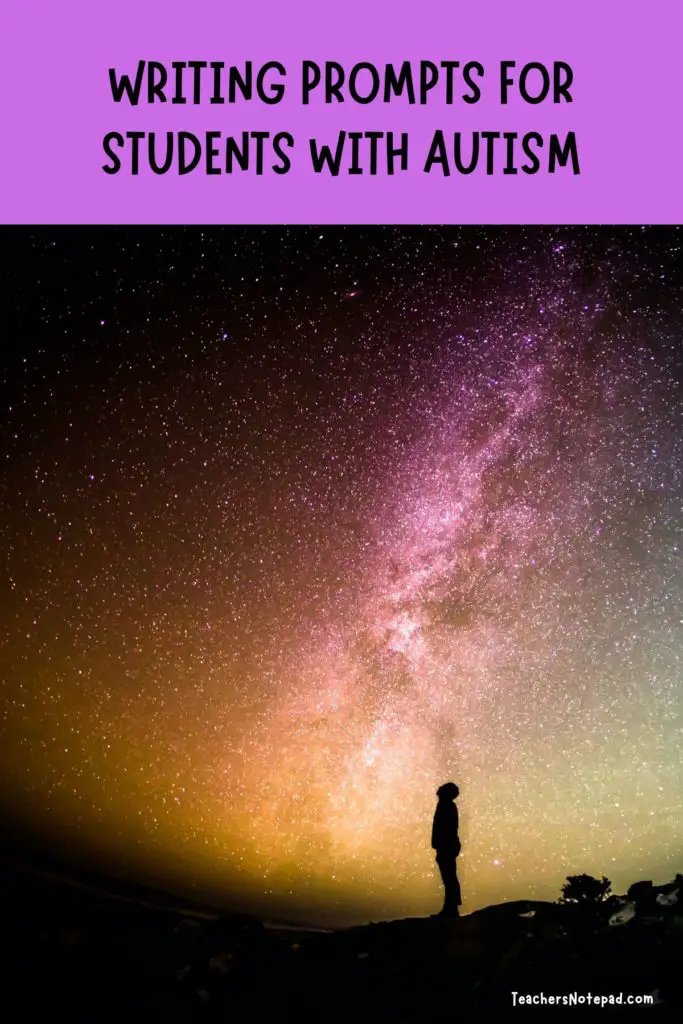Journaling is a soothing and reflective process that has proven mental health benefits.
If you have students with autism, you know that the writing process doesn’t look the same for neurodivergent people as it does for neurotypical people.
These prompts are simple enough that those who struggle with writing can answer them simply, either with words or with pictures, but can be used to write in more detail for those students who have an easier time with the journaling process.
How to use these prompts:
You can use this guide in your classroom as a way to help students process and reflect. They can be writing prompts, or you could assign them as visual prompts if needed. Here are a few fun ways to use this list in your curriculum:
- Keep these prompts handy if you have students who decompress and de-escalate best by journaling or spending time by themselves.
- Encourage your students to use one prompt and spend time journaling every day for a week.
- Adapt these prompts so students can use them in various ways, like tracing, coping, or free-writing.
The Writing Prompts
- List three things that make you unique.
- What activities make you feel most calm and at peace?
- What did you eat for dinner last night?
- What is your favorite hobby?
- What is your favorite movie?
- What kind of music do you like to listen to?
- I feel accepted when…
- I feel safest when…
- Write about a time when you were proud of yourself.
- What is your favorite iPad or computer game?
- What do you like to watch on YouTube?
- Write about what makes you feel happiest.
- Talk about something you’re deeply interested in.
- Write about your favorite holiday. Why is it your favorite?
- What do you wish people understood about you?
- What do you like to do when it’s hot outside?
- What do you like to do when it’s cold outside?
- Write about your favorite food. Why is it your favorite?
- What kind of community worker do you think is the most important? Why?
- What is your favorite planet? Why?
- Write about the last dream you remember. Use as much detail as possible.
- Do you have a favorite dinosaur? Write about it.
- What is your favorite activity to do in a group?
- What is your favorite activity to do by yourself?
- Write about your ideal day. What do you do? Who are you with?
- What is your morning routine? Write with as much detail as you can.
- What is your nightly routine? Write with as much detail as you can.
- Does writing help you calm down? Explain.
- What is your dream vacation? Write about it in as much detail as you can.
- Do you have any pets? Describe them.
- Do you have any siblings? Write about them.
- If you don’t have any siblings, do you wish you did? Explain.
- Where do you like to go to relax? What about this space is soothing?
Helpful Strategies for Teaching Children with Autism
Compared to their neurotypical peers, children with autism have different needs when it comes to learning. Each child is unique, but children with autism are especially unique and each needs specific care and direction when in a classroom setting.
Here are a few things you can do to help your autistic students succeed:
- Model appropriate behavior.Your students will watch and mirror what you do. Stay calm, even in moments of frustration, and use calming techniques to help yourself get back on track. Not only will this behavior be beneficial for you, but your students will also learn from these actions.
- Support the need for routines.Many individuals with autism thrive with routine, and their entire day can be affected by a change in this routine. Try to stick to a routine in the classroom, and help your students transition from one activity to the next by giving them cues (i.e. “We are going to switch to writing in five minutes”) or using a visual timer that they can see. Give your students extra support if transitions are difficult, or if you have to make a change in their routine.
- Use special interests as a teaching tool. In general, individuals with autism have at least one special interest. Get to know your students, and use their special interest to help them learn. This could be as simple as downloading dinosaur-themed writing pages or teaching appropriate behavior by modeling their favorite cartoon character.
- Support socialization in the classroom and on the playground. Children with autism can often become isolated among their peers, so it’s important to teach acceptance and positivity to your entire class on a regular basis. Allow students time to work in pairs or in groups, and encourage them to include everyone in their activities during recess.
Looking For More Teaching Resources?
If you’re looking for thousands of free teaching resources, you’ve come to the right place.
We offer an abundance of writing and learning tools to aid teachers in helping their students succeed.
If you need something specific and we don’t have it on our site yet, reach out and let us know! We’re here to help you and your classroom succeed.


